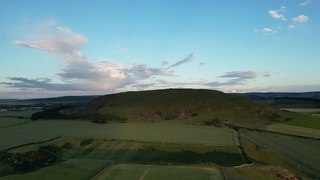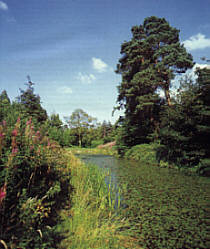

Carcant is a small settlement and a wind farm, near Heriot in the Scottish Borders area of Scotland.
Contents
A famous inhabitant of Carcant was Eric Liddell.


Carcant is a small settlement and a wind farm, near Heriot in the Scottish Borders area of Scotland.
A famous inhabitant of Carcant was Eric Liddell.
Carcant is etymologically a Cumbric place-name. The first element is cognate with Welsh caer 'fortification'. The second might be can 'white', in which case the name means 'white fort'; but more likely it is cant 'edge of a circle', in this context probably meaning 'district, region, edge, border', thus giving 'fort of the region/border'. [1]

Traprain Law is a hill 6 km (4 mi) east of Haddington, East Lothian, Scotland. It is the site of a hill fort or possibly oppidum, which covered at its maximum extent about 16 ha. It is the site of the Traprain Law Treasure, the largest Roman silver hoard from anywhere outside the Roman Empire which included exquisite silver artefacts.

Binchester is a small village in County Durham, England. It has a population of 271. It is situated between Bishop Auckland, which is to the south, and a short distance to the west of Spennymoor. It has a community centre, swing park and football field, and is surrounded by countryside. Granville Terrace, the main road through the village, was relaid and renovated in 1991 for the BBC television series Challenge Anneka.

Cambois is a village in south-east Northumberland, England. It is situated on the north side of the estuary of the River Blyth between Blyth and Ashington on the North Sea coast.
Caerlanrig - also spelled 'Carlenrig' - is a hamlet in the parish of Cavers, Borders, Scotland, lying on the River Teviot, 6 miles (10 km) north east of that river's source, and 10 miles (16 km) south west of Hawick.

Cammo is a northwestern suburb of Edinburgh, the capital of Scotland. It is south of A90, at the edge of the city, approximately 6 miles from the city centre.

Coria was a fort and town 2.5 miles (4.0 km) south of Hadrian's Wall, in the Roman province of Britannia at a point where a big Roman north–south road bridged the River Tyne and met another Roman road (Stanegate), which ran east–west between Coria and Luguvalium in the Solway Plain. The full Latin name is uncertain. In English, it is known as Corchester or Corbridge Roman Site as it sits on the edge of the village of Corbridge in the English county of Northumberland. It is in the guardianship of English Heritage and is partially exposed as a visitor attraction, including a site museum.

Crichton is a small village and civil parish in Midlothian, Scotland, around 2 miles (3 km) south of Pathhead and the same distance east of Gorebridge.
Eden Water is a tributary of the River Tweed in the Scottish Borders of Scotland. "Water" is the Lowland Scots term for a small river.

Eccles is a village and agricultural parish near Kelso in Berwickshire in the Scottish Borders area of Scotland. The village is conjoined with Birgham and Leitholm.

Low Cocklaw is a small hamlet about 3 miles (5 km) west of Berwick-upon-Tweed, England. Until the early 1980s it was a working farm but is now entirely residential. It is surrounded by rolling farmland which is dominated by cereal growing.

Carham or Carham on Tweed is a village in Northumberland, England. The village lies on the south side of the River Tweed about 3 miles (5 km) west of Coldstream. According to the United Kingdom Census 2011, it is the place in England with greatest proportion of Scottish-born people, at approximately 33%.

Craik is a hamlet in Craik Forest, by the Airhouse Burn in the Scottish Borders area of Scotland, close to Roberton, Scottish Borders.

Cardrona is a village on the A72 and B7062, between Peebles and Innerleithen, in the Scottish Borders area of Scotland.

Ettleton is a village near Castleton, in the Scottish Borders area of Scotland, in the former Roxburghshire.

Milecastle 31 (Carrawburgh) was a milecastle of the Roman Hadrian's Wall. Its remains exist as a turf covered platform beside (and partially covered by) the B6318 Military Road, just to the east of Carrawburgh fort (adjoining the car park).

Milecastle 32 (Carraw) was a milecastle of the Roman Hadrian's Wall. Its remains exist as earthworks and with no exposed masonry. The layout of the milecastle walls is defined (still quite evident) by robber trenches (to a maximum depth of 0.3 metres (1 ft 0 in). The north wall is beneath a modern wall.
Halltree is a hamlet in the Scottish Borders.
Dinley is a hamlet in the Scottish Borders through which Hermitage Water flows.

Dreva on Tweed is a hamlet in the Scottish Borders. It was historically in Peebles-shire.

Hepburn is a hamlet and former civil parish, now in the civil parish of Chillingham in the county of Northumberland, England. The civil parish was merged into Chillingham in 1935. In 1951 the civil parish had a population of 43.
55°45′43″N3°00′47″W / 55.762°N 3.013°W